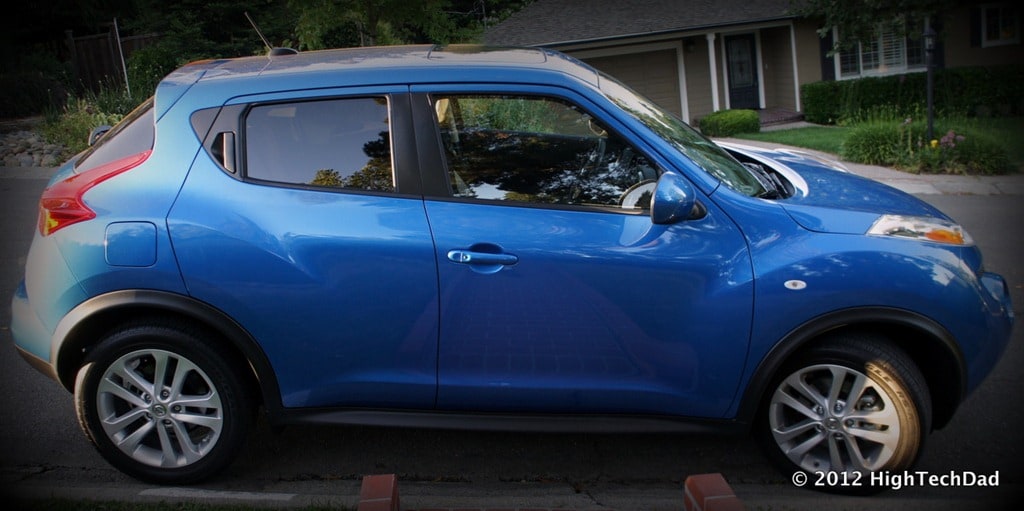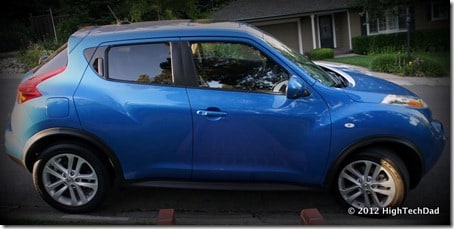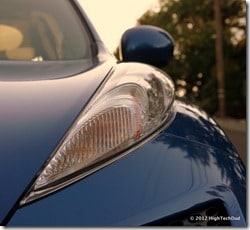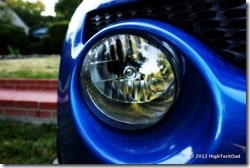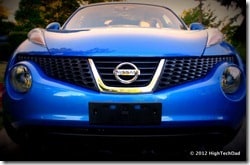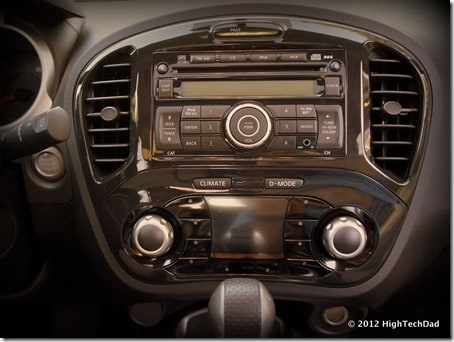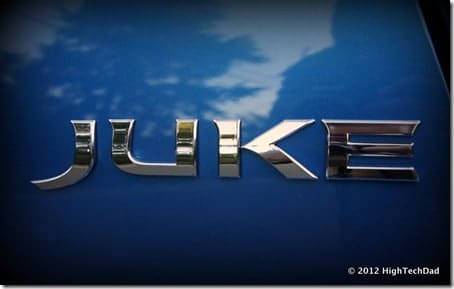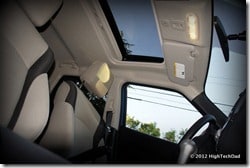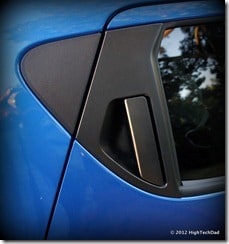The 2012 Nissan Juke is a pretty unique car. It has a crossover styling and Nissan bills it as “the bold urban sport crossover.” And they aren’t kidding. The Juke is very distinctive when it drives by. I remember first reading about the Juke and how it was targeted towards 20-30 year old males. Well, I can tell you that the demographic may be a bit broader as my family did have a lot of fun with the Juke. It is definitely designed for more of an urban environment, being compact to squeeze into small parking spots, zipping around corners and dodging traffic. Yet is can fairly comfortably transport a family of 5 (and a small dog) here and there in a suburban environment. For a road trip, I would limit it to 2 people so that you can load up the back with your gear.
With the unique styling also comes fun. I found the Juke to be pretty enjoyable to drive. In fact, there is one word that I used repeatedly in my video below to describe it – “peppy.” (I think I said “peppy” about 5 times!) So what drives the peppiness of the Juke? A few things: its turbocharged engine and its low weight. The Juke has a 1.6 liter direct injection turbocharged 4-cylinder engine which cranks out 188 hp. That’s not a super huge amount of horsepower but when you consider that the Juke only weighs about 3000 lbs, that is enough pep to really move this compact crossover around. Just in comparison, the Nissan Rogue (which is the car that I actually own) has less horsepower (170 hp) and weighs about 200-400 lbs more. So given these factors, the Juke has a sticky and quick ride. The handling was tight and grippy, and when the turbo kicked in, you could throw people back in their seats.
The styling of the Juke is different, and not different in a bad way, it is just that it does take some time to get used to. Its very youthful and has definite themes that run throughout the vehicle. For example, there are dramatic bulbous ovals throughout various components of the body. You can see it most prominently in the front lights.
But there are also some Rally Car inspired headlights…
…and an aggressive front grill, complete with ovals and circles…
Even the interior has the rounded oval curves throughout the design. Below is the front center console (the only thing that seemed a bit out of place stylistically was the CD/Satellite/Radio player) that was also well-rounded.
The Juke is a comfortable car, it seats a family of 5 quite well (assuming you put all of the kids in the back seat) and probably 4 adults decently. It is a 4-door (actually 5-door if you consider the hatchback) so it is easy for people to get in or out of the Juke.
Before I go into some additional details, be sure to watch my video review of the 2012 Nissan Juke below. This video is also directly available on YouTube.
[youtube]http://youtu.be/mVlvf_sUTZU[/youtube]
The 2012 Nissan Juke that I test drove was the SV front wheel drive version. There is also an all wheel drive version and another trimline above and below the SV (the S and the SL respectively). The SV came with quite a good set of standard features including a 6-speaker XM satellite radio, Bluetooth hands-free phone system, push start ignition, privacy glass, power sliding moon roof, cruise control, and 17″ aluminum alloy wheels. With all of these items (and more), the 2012 Nissan Juke SV FWD topped out at $22,515 MSRP. For about $2000 more, you can get navigation, a rear-view camera, upgraded speakers AND a subwoofer, leather heated (front) seats and automatic on/off headlights. In my opinion, it’s definitely worth upgrading to the SL.
One of the coolest things of the Juke was something demoed in the video above. Directly below the radio (or navigation if you have that option) is what I call the Climate/D-Mode module. Nissan calls it the I-CON (Integrated Control) system. You can really tell that this particular section of the car was really thought out. For starters, above a smaller screen are two buttons: Climate (obviously for climate control) and D-Mode (which stands for Drive Mode). One great design choice that Nissan made was by using the same buttons for these completely distinct function. If you push the Climate button, the buttons below transform into functions directly related into controlling the climate. If you push the D-Mode button, the same buttons below change to a different color and have entirely different function related to how the car drives.
Climate control is pretty obvious and was very intuitive and easy to use. You can even push a knob to simply set it to automatic mode. But the fun came when you started playing around with the D-Mode functions. When you are in Drive Mode, the Juke has three drive options: Eco, Normal and Sport. On the fly, you can change the properties of how the CVT (Continuously Variable Transmission) engine and other items act. For example, if you want to conserve gas and get better gas mileage, hitting the Eco mode will lower where you redline and reduce the power going to the engine. In this mode, the car definitely feels sluggish and without that “pep.” Also, your climate controls (e.g., air conditioning) is modified to prevent gas guzzling. Normal mode is exactly that – everything is set to normal. When you fire up the Juke, it is set to Normal which is fine for most people for both city and highway. However, when I fired up the Juke, I always put it into Sport mode. And that is were the “peppy” comes into play. In sport mode, things feel…well…sportier. For starters the redline is higher. Normally with CVTs, you don’t really notice the engine changing gears. You do in sport mode. And if you want even more control, you can manually shift the automatic as well. Each of the modes have their own meter on the mini display: Eco shows an “Eco meter” – don’t accelerate hard or you will have lower Eco ratings, “Torque” is displayed in Normal mode and “Boost” (I like to think of it as the turbo meter) in the Sport mode.
Regardless of the fact that I drove mainly in Sport mode (and my wife in Normal mode), we were able to average about 26-27 miles to the gallon. The Juke is actually rated a 27 city and 32 highway. I’m pretty sure that is achievable.
One more last little tidbit, it took me and my kids a few second to figure out where the rear door handles were. They are not where you would expect them to be, but rather, higher up on the door and hidden into the design a bit and vertical instead of horizontal. Still, they were easy for my kids to open.
If you are interested in seeing some other photos that I took of the 2012 Nissan Juke, you can either view them on my Flickr page in this set, or you can watch the video slideshow below:
[youtube]http://youtu.be/dzDqeE6NAcA[/youtube]
The 2012 Nissan Juke would be a great car for a college or grad-school bound student (potentially toward more of a male audience). You can load it up with gear, it’s definitely fun to drive, you can safely transport 5 people (4 quite comfortably), it gets great gas mileage for a non-hybrid car and it is unique and distinct on the road. Also, the All Wheel Drive version can make those camping or ski trips a bit more easy to get to. Oh yeah, and did I mention that it’s “peppy?”
HTD says: While the 2012 Nissan Juke isn’t a car for everybody, if you like the styling, you can definitely have a lot of fun with it!
